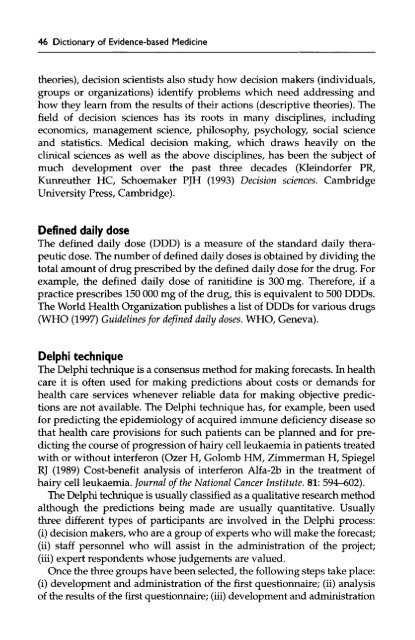Dictionary of Evidence-based Medicine.pdf
Dictionary of Evidence-based Medicine.pdf
Dictionary of Evidence-based Medicine.pdf
You also want an ePaper? Increase the reach of your titles
YUMPU automatically turns print PDFs into web optimized ePapers that Google loves.
46 <strong>Dictionary</strong> <strong>of</strong> <strong>Evidence</strong>-<strong>based</strong> <strong>Medicine</strong><br />
theories), decision scientists also study how decision makers (individuals,<br />
groups or organizations) identify problems which need addressing and<br />
how they learn from the results <strong>of</strong> their actions (descriptive theories). The<br />
field <strong>of</strong> decision sciences has its roots in many disciplines, including<br />
economics, management science, philosophy, psychology, social science<br />
and statistics. Medical decision making, which draws heavily on the<br />
clinical sciences as well as the above disciplines, has been the subject <strong>of</strong><br />
much development over the past three decades (Kleindorfer PR,<br />
Kunreuther HC, Schoemaker PJH (1993) Decision sciences. Cambridge<br />
University Press, Cambridge).<br />
Defined daily dose<br />
The defined daily dose (DDD) is a measure <strong>of</strong> the standard daily therapeutic<br />
dose. The number <strong>of</strong> defined daily doses is obtained by dividing the<br />
total amount <strong>of</strong> drug prescribed by the defined daily dose for the drug. For<br />
example, the defined daily dose <strong>of</strong> ranitidine is 300 mg. Therefore, if a<br />
practice prescribes 150 000 mg <strong>of</strong> the drug, this is equivalent to 500 DDDs.<br />
The World Health Organization publishes a list <strong>of</strong> DDDs for various drugs<br />
(WHO (1997) Guidelines for defined daily doses. WHO, Geneva).<br />
Delphi technique<br />
The Delphi technique is a consensus method for making forecasts. In health<br />
care it is <strong>of</strong>ten used for making predictions about costs or demands for<br />
health care services whenever reliable data for making objective predictions<br />
are not available. The Delphi technique has, for example, been used<br />
for predicting the epidemiology <strong>of</strong> acquired immune deficiency disease so<br />
that health care provisions for such patients can be planned and for predicting<br />
the course <strong>of</strong> progression <strong>of</strong> hairy cell leukaemia in patients treated<br />
with or without interferon (Ozer H, Golomb HM, Zimmerman H, Spiegel<br />
RJ (1989) Cost-benefit analysis <strong>of</strong> interferon Alfa-2b in the treatment <strong>of</strong><br />
hairy cell leukaemia. Journal <strong>of</strong> the National Cancer Institute. 81: 594-602).<br />
The Delphi technique is usually classified as a qualitative research method<br />
although the predictions being made are usually quantitative. Usually<br />
three different types <strong>of</strong> participants are involved in the Delphi process:<br />
(i) decision makers, who are a group <strong>of</strong> experts who will make the forecast;<br />
(ii) staff personnel who will assist in the administration <strong>of</strong> the project;<br />
(iii) expert respondents whose judgements are valued.<br />
Once the three groups have been selected, the following steps take place:<br />
(i) development and administration <strong>of</strong> the first questionnaire; (ii) analysis<br />
<strong>of</strong> the results <strong>of</strong> the first questionnaire; (iii) development and administration










